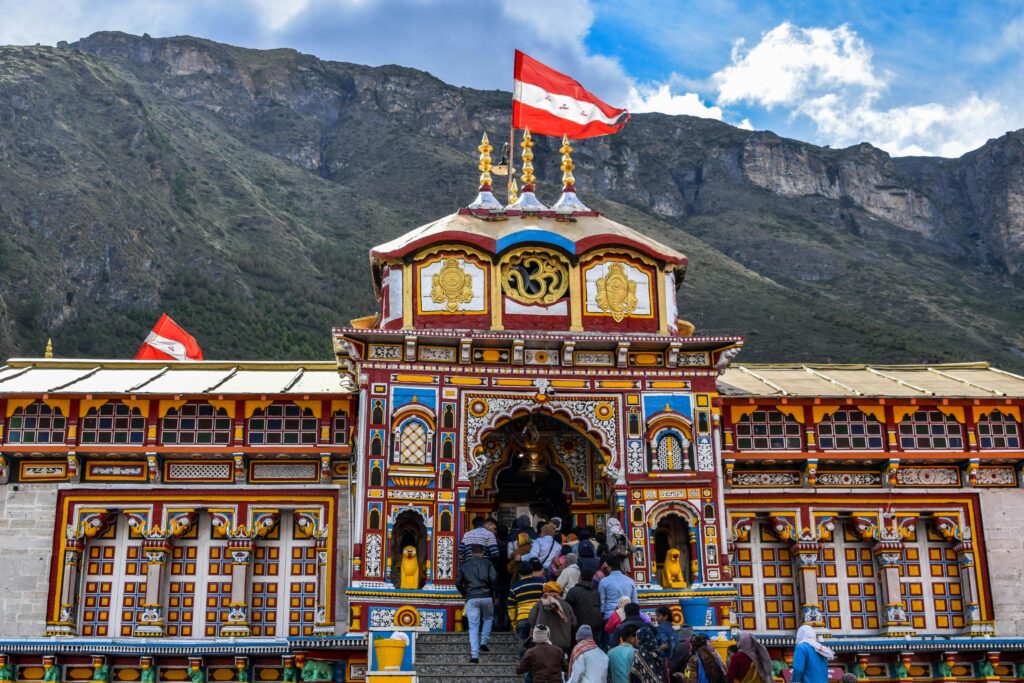
Badrinath Dham
History of Badrinath
Badrinath is one of the most revered Hindu pilgrimage sites, located in the state of Uttarakhand, India. It is part of the Char Dham Yatra, a pilgrimage circuit that includes Yamunotri, Gangotri, Kedarnath, and Badrinath. The history of Badrinath is deeply entwined with Hindu mythology, religion, and tradition. Here’s an overview of its historical significance:
- Mythological Significance
Lord Vishnu: Badrinath is dedicated to Lord Vishnu, one of the principal deities of Hinduism, often worshipped in his “Badri” or “Badrinath” form. According to Hindu mythology, Lord Vishnu meditated here to atone for his sins and seek peace. The name “Badrinath” comes from the word “Badri” (meaning “berry” or “berry tree”), as it is believed that the area was once covered with wild berry trees (Badri).
Legend of Goddess Lakshmi: Another mythological story associated with Badrinath is that the goddess Lakshmi (Vishnu’s consort) once turned into a berry tree to protect Lord Vishnu during his meditation. The location is considered to be a sacred site where Vishnu continues his eternal meditation. - Historical Origins
Ancient References: The history of Badrinath is mentioned in several ancient scriptures and texts, including the Skanda Purana and Bhagavata Purana. These texts describe Badrinath as a sacred place of worship and the seat of Lord Vishnu’s divinity.
Vedic Period: Badrinath is believed to have been an important pilgrimage site since ancient times, with evidence pointing to the temple’s existence since the Vedic period. The temple was likely visited by sages and pilgrims long before it became a major pilgrimage center.
Puranic References: Several Puranas mention Badrinath as a significant site for those seeking salvation and peace. - Construction of the Temple
The current structure of the Badrinath Temple was established by Adi Shankaracharya in the 9th century. Adi Shankaracharya, a key figure in the history of Hinduism, is credited with reviving and consolidating the teachings of the Vedas and the Upanishads, and he is also responsible for the establishment of the Char Dham pilgrimage circuit.
According to tradition, the temple at Badrinath was originally a simple shrine, and the present temple structure, with its elaborate architecture, was built during the medieval period under the patronage of various rulers and local authorities.
The temple’s main deity is Lord Badrinath, represented as a black stone idol, which is about 1.5 feet tall. The idol is carved in the sitting posture with two hands. - Dynastic Influence
Various rulers and dynasties over the centuries have contributed to the temple’s development. Among them, the Kashmirian rulers and Garhwal kings played significant roles in preserving and expanding the temple complex.
The region of Badrinath has witnessed multiple invasions and natural disasters, but the temple continued to be an important site of worship and pilgrimage through the centuries. - Pilgrimage and Its Cultural Significance
Char Dham Yatra: Badrinath is part of the Char Dham Yatra, one of the holiest pilgrimages for Hindus. Pilgrims come from all over India and beyond to visit this sacred site, especially during the summer months when the temple is open for worship (between May and November).
The temple and the surrounding area are not only important for their religious significance but also for their natural beauty and cultural heritage. The region is surrounded by snow-capped mountains, making it an extraordinary destination for both spiritual and natural exploration. - Modern Times
Badrinath is a major center of pilgrimage today, and the town has seen significant development over the years. The temple is maintained by the Badrinath-Kedarnath Temple Committee (BKTC), which oversees the administration of both Badrinath and Kedarnath shrines.
The shrine has been expanded, with the construction of roads, accommodations for pilgrims, and other infrastructure to support the growing number of devotees. The popularity of the Char Dham Yatra continues to draw thousands of visitors every year. - The Pilgrimage Circuit:
As part of the Char Dham circuit, Badrinath is considered one of the holiest destinations for Hindus. The pilgrimage, which attracts devotees from all corners of the world, is believed to offer salvation and an opportunity to wash away sins.
Conclusion
Badrinath’s rich history, rooted in mythology and religious devotion, has made it a timeless and spiritual destination. Its significance has only grown over the centuries, attracting pilgrims from around the world and remaining an important hub for Hindu worship, culture, and tradition.
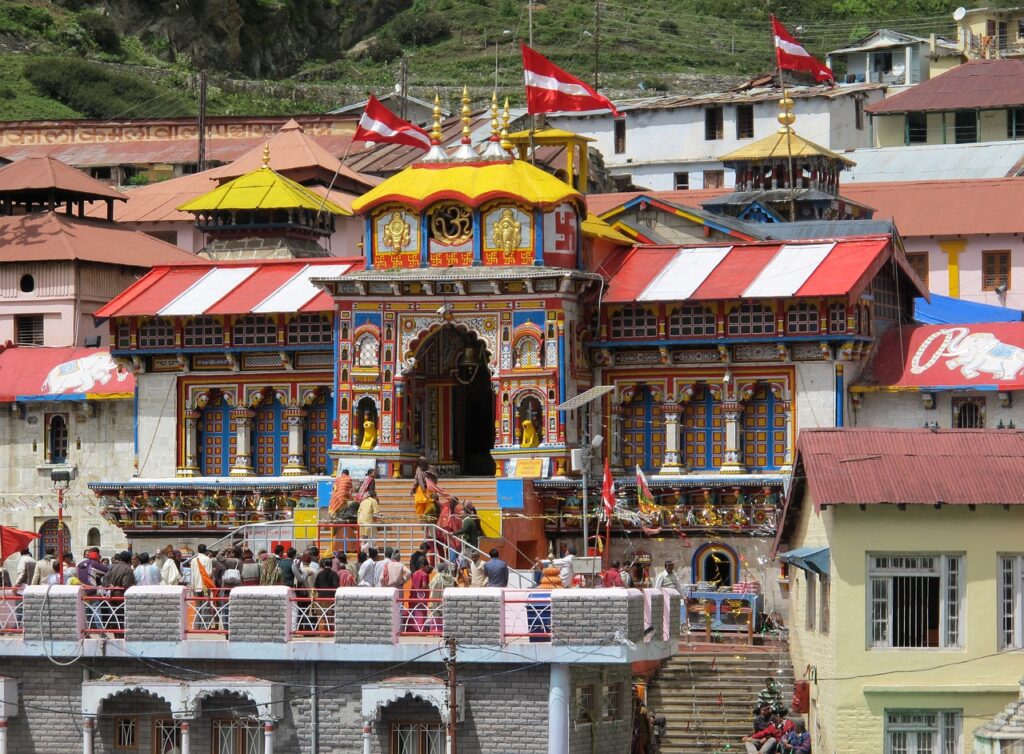
Badrinath’s rich history, rooted in mythology and religious devotion, has made it a timeless and spiritual destination. Its significance has only grown over the centuries, attracting pilgrims from around the world and remaining an important hub for Hindu worship, culture, and tradition.
- Location and Significance
Badrinath is a prominent Hindu pilgrimage site located in the Indian state of Uttarakhand. It is situated in the Chamoli district in the Garhwal Himalayas, at an elevation of 3,133 meters (10,279 feet) above sea level. The temple of Badrinath is dedicated to Lord Vishnu, who is worshipped in the form of Badri Narayan. - Religious Importance
Badrinath is one of the four sacred shrines in the Char Dham Yatra, a significant pilgrimage circuit for Hindus. The Char Dham Yatra consists of the following four holy sites:
Yamunotri
Gangotri
Kedarnath
Badrinath
Pilgrims from all over the world visit Badrinath as part of this sacred journey. The pilgrimage is believed to cleanse one’s soul and grant salvation. - Legend and Mythology
According to Hindu mythology, Lord Vishnu meditated at this sacred place to attain peace and to protect the world from evil. Badrinath is also associated with Goddess Lakshmi, who is said to have turned into a berry tree to protect Vishnu during his meditation. The name “Badrinath” comes from the word “Badri”, which means a berry tree.
- History of the Temple
The current Badrinath Temple was built by the famous Hindu saint Adi Shankaracharya in the 9th century. Shankaracharya was instrumental in reviving and consolidating the teachings of Hinduism, particularly the Advaita Vedanta philosophy.
- Geography and Climate
Badrinath is surrounded by majestic snow-capped mountains and valleys, making it a place of breathtaking natural beauty. The region is known for its serene environment and divine atmosphere.
- Pilgrimage and Tourism
Badrinath Temple is not just a religious site; it has become a hub for both spiritual seekers and adventure tourists. Pilgrims travel to Badrinath as part of their Char Dham Yatra, while others visit the town for its scenic beauty and the opportunity to connect with nature and spirituality.
- Management of the Temple
>The Badrinath-Kedarnath Temple Committee (BKTC) oversees the management and administration of the temple. This committee ensures the smooth functioning of the pilgrimage, including the safety and accommodation of pilgrims.
- Festivals
Several religious festivals are celebrated in Badrinath, especially during the summer season. Some of the important festivals include:
Makar Sankranti
Akshaya Tritiya
Janmashtami
Diwali
These festivals attract thousands of pilgrims and devotees who come to witness the grandeur of the celebrations and seek blessings from Lord Vishnu.
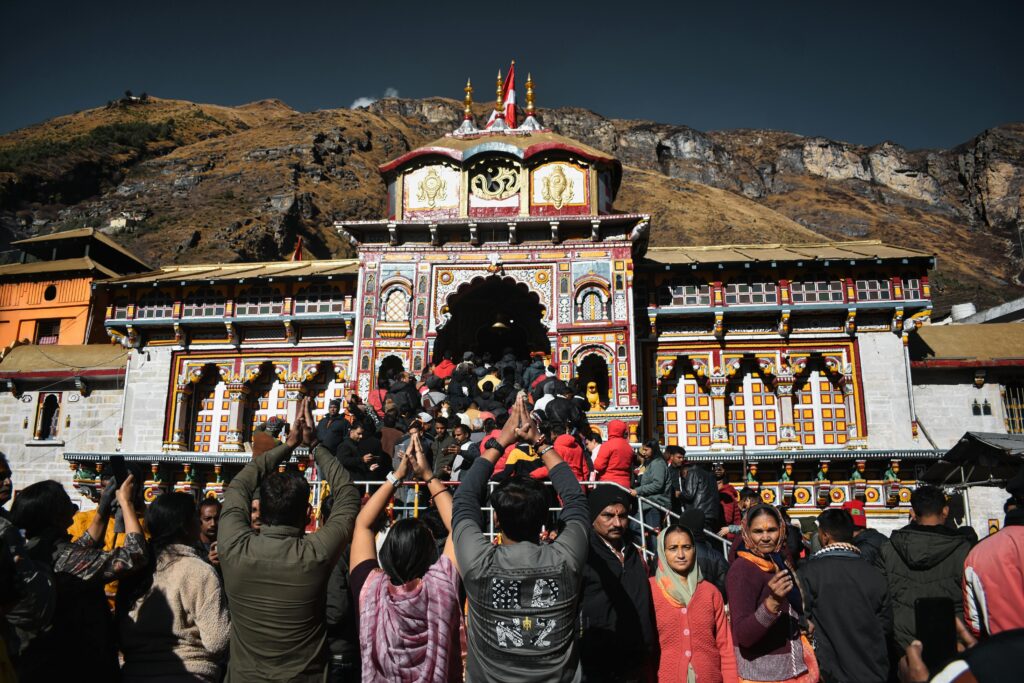
- Badrinath Temple
The most famous and significant site in Badrinath is the Badrinath Temple, dedicated to Lord Vishnu. It is one of the holiest shrines in Hinduism and a key part of the Char Dham Yatra. The temple attracts thousands of pilgrims every year and is renowned for its spiritual significance and the idol of Badri Narayan. - Tapt Kund (Hot Springs)
Tapt Kund is a natural hot spring located near the Badrinath temple. Pilgrims take a dip in the hot water before entering the temple to purify themselves. The waters are believed to have healing properties, making Tapt Kund an essential part of the pilgrimage experience in Badrinath. - Mana Village
Mana Village is located around 3 kilometers from Badrinath and is the last village on the Indian side of the border with Tibet. It holds historical and spiritual significance as it is believed to be the home of the sage Vyasa, the author of the Mahabharata. Mana village is also famous for its scenic beauty and trekking routes, offering stunning views of the surrounding mountains. - Neelkanth Peak
Neelkanth Peak is a prominent mountain visible from Badrinath. It is also referred to as the “Blue Mountain” due to its distinct blue color. The peak stands tall over Badrinath and adds to the majestic landscape of the region. It is a popular site for nature lovers and photographers. - Brahma Kapal
Brahma Kapal is a sacred spot situated near the Badrinath temple, located on the banks of the Alaknanda River. It is believed to be the place where offerings are made for the peace of the departed souls. Many pilgrims perform shraddh rites (a ritual for the ancestors) at Brahma Kapal. - Alaknanda River
The Alaknanda River, which flows near the Badrinath temple, is considered sacred in Hinduism. Pilgrims often take a ritual bath in the river after visiting the temple. The river’s serene beauty adds to the spiritual aura of the area. - Satopanth Lake
Satopanth Lake is a high-altitude, pristine lake located about 25 kilometers from Badrinath. It is surrounded by snow-capped peaks and is considered a sacred site. According to legend, this lake is believed to be where the trio of Lord Brahma, Vishnu, and Shiva meditated. It is a popular trekking destination for adventure enthusiasts. - Vyas Gufa (Cave)
Vyas Gufa is a cave located near Mana village. It is believed to be the place where the great sage Vyasa composed the Mahabharata. The cave is an important site for spiritual seekers and scholars. - Panch Shila
Panch Shila is a group of five temples dedicated to various gods and goddesses in the Badrinath region. These temples are less crowded than the main Badrinath temple but are still important for those who want to explore the full spiritual experience of the area. - Charanpaduka
Charanpaduka is a rock formation located on a hill near the Badrinath temple. It is believed to be the place where Lord Vishnu’s footprints are imprinted. This site is a popular spot for pilgrims who want to seek Lord Vishnu’s blessings.
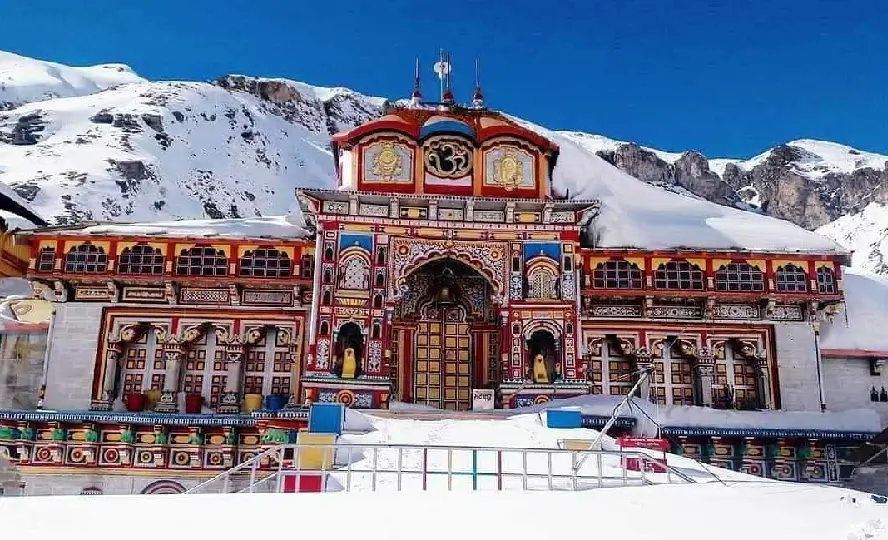
Badrinath is a very special and revered place in India, known for its spiritual, historical, and natural significance. It is located in the Garhwal Himalayas in the state of Uttarakhand. Here’s a breakdown of why Badrinath is considered such a significant and unique place:
- Religious Importance
Badrinath is one of the four sacred shrines in the Char Dham Yatra, which also includes Yamunotri, Gangotri, and Kedarnath. These shrines are considered the holiest pilgrimage destinations in Hinduism, and visiting all four is believed to lead to moksha (liberation from the cycle of birth and death).
The town is home to the famous Badrinath Temple, dedicated to Lord Vishnu in his form as Badri Narayan. It is a major pilgrimage site for Hindus, attracting thousands of devotees every year. The temple is believed to have been established by Adi Shankaracharya in the 9th century. - Spiritual and Mythological Significance
According to Hindu mythology, Lord Vishnu meditated at Badrinath to protect the world, and the place is believed to be blessed by the presence of Lord Vishnu and Goddess Lakshmi.
The name “Badrinath” comes from the word “Badri”, which means berry tree, as it is said that Goddess Lakshmi turned into a berry tree to protect Lord Vishnu while he meditated here. - Breathtaking Natural Beauty
Badrinath is located at a high altitude of 3,133 meters (10,279 feet) above sea level, surrounded by snow-capped mountains and lush valleys. The scenery is absolutely stunning, with the Alaknanda River flowing nearby, creating a serene and peaceful atmosphere.
The region is known for its natural beauty, with majestic Himalayan peaks, clean rivers, and a peaceful, tranquil environment perfect for reflection and meditation. - Tapt Kund (Hot Springs)
One of the unique features of Badrinath is the Tapt Kund, a natural hot spring located near the temple. Pilgrims take a ritual dip in the hot water of the spring before visiting the temple. The water is believed to have healing properties and purifies the body and soul. - Mana Village
Mana Village, located near Badrinath, is the last inhabited village on the Indian side of the Tibetan border. It is an important site for pilgrims and tourists, known for its scenic beauty and mythological significance. It is said to be the place where Sage Vyasa wrote the Mahabharata. - Neelkanth Peak
The Neelkanth Peak is one of the most beautiful and prominent peaks in the Badrinath region. It is often referred to as the “Blue Mountain” because of its striking appearance. The peak stands tall above the town and adds to the awe-inspiring landscape. - Climate and Best Time to Visit
The climate in Badrinath is generally cold throughout the year, with harsh winters and heavy snowfall. The best time to visit is from May to November when the temple is open. During this time, the weather is more favorable for pilgrims, with temperatures ranging between 10°C to 20°C. - Accessibility
Badrinath is accessible by road from Joshimath, which is connected to major cities like Rishikesh and Haridwar. The journey to Badrinath is an adventure in itself, with winding roads and dramatic landscapes along the way.
The area is only accessible for six months of the year due to heavy snowfall in the winter months, so it is important to plan the visit accordingly.
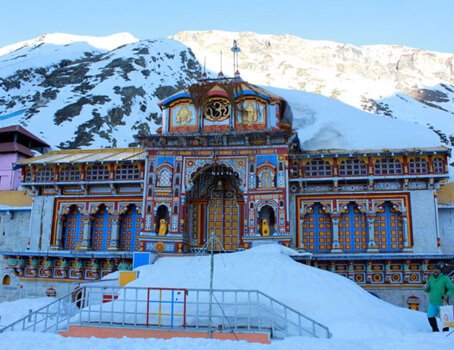
Badrinath holds immense significance and manyata (importance) in Hinduism for several reasons, which combine its spiritual, historical, mythological, and natural attributes. Here’s why Badrinath is so revered:
- Religious Significance
Badrinath is one of the Char Dhams of India, which are considered the holiest places for Hindu pilgrimage. The Char Dham Yatra includes Yamunotri, Gangotri, Kedarnath, and Badrinath. Pilgrims who visit all four sites are believed to attain moksha (salvation or liberation from the cycle of birth and death).
The Badrinath Temple is dedicated to Lord Vishnu, one of the most important deities in Hinduism, specifically in his form as Badri Narayan. As one of the 108 Divya Desams (sacred shrines of Lord Vishnu), Badrinath is a place of worship that attracts millions of devotees. - Mythological Importance
According to Hindu mythology, Lord Vishnu meditated at Badrinath for the protection of the universe. It is said that Lord Vishnu, after a long period of meditation, was blessed by Goddess Lakshmi, who turned into a Badri (berry) tree to shield him from the sun and keep him cool. The town is named after this berry tree, Badri.
Badrinath is believed to be one of the Sapta Puri (seven sacred cities) that hold immense importance in Hindu mythology, which is said to purify the soul of its devotees. - Connection with the Pandavas (Mahabharata)
According to the Mahabharata, after the great battle of Kurukshetra, the Pandavas (the five brothers) sought to atone for their sins. They traveled to Badrinath, meditated, and performed religious rituals to purify themselves. This connection to the Pandavas further elevates Badrinath’s status as a holy site, as the Pandavas are considered great heroes in Hindu epics. - Role of Adi Shankaracharya
Adi Shankaracharya, a great philosopher and spiritual leader, is credited with revitalizing and establishing the importance of Badrinath Temple in the 9th century CE. He is believed to have visited Badrinath and restored the temple’s significance as a center of Advaita Vedanta (non-dualistic philosophy). He is also said to have established the Badrinath Matha (monastic center) to ensure the continuity of religious practices. - Sacred Geography
Badrinath is located at an elevation of 3,133 meters (10,279 feet) in the Garhwal Himalayas, surrounded by snow-capped mountains and serene natural beauty. It is situated on the banks of the Alaknanda River, which is considered sacred in Hinduism.
The geography of Badrinath adds to its religious importance, with the Himalayas symbolizing the presence of divine energy and the river representing the flow of purity and devotion. - Spiritual and Healing Properties
The Tapt Kund (hot springs) near the temple is believed to have healing properties, and pilgrims take a dip in the waters to purify themselves spiritually and physically before entering the temple to worship. This purification ritual strengthens Badrinath’s spiritual significance.
The town’s serene environment and peaceful atmosphere make it an ideal place for meditation, prayer, and spiritual awakening. - Part of the Char Dham Yatra
As part of the Char Dham Yatra, Badrinath attracts thousands of pilgrims every year who consider it an essential part of their spiritual journey. It is believed that visiting all four dhams ensures the ultimate goal of liberation (moksha) and a connection with the divine.
The Char Dham Yatra is considered a powerful pilgrimage, where devotees seek divine blessings, purification, and inner peace. - Historical and Cultural Importance
Over the centuries, Badrinath has been a significant cultural and religious hub. Its association with various dynasties, sages, and saints over the ages has only enhanced its importance. The temple has been mentioned in several ancient texts, and the place has been a center for the study and practice of Hinduism. - Miracles and Divine Presence
There are numerous legends and miracles associated with the temple and the town that add to its mystical and divine reputation. Pilgrims and visitors report experiencing a strong spiritual connection or feeling of divine presence while in Badrinath. - Access to Moksha (Salvation)
In Hindu belief, visiting Badrinath and performing certain religious rituals can help cleanse one’s sins and bring them closer to moksha. As a result, many consider Badrinath to be the ultimate destination for spiritual fulfillment, making it one of the most revered pilgrimage sites in the world.

Badrinath remains closed for six months of the year due to harsh winter conditions in the region. The area experiences extreme cold with heavy snowfall, making it difficult for pilgrims and residents to access the temple and surrounding areas. The key reasons for the temple being closed during the winter months are:
- Harsh Weather Conditions
Heavy Snowfall: During the winter, from November to April, Badrinath experiences heavy snowfall, which blocks roads and makes the region inaccessible. The cold temperatures can go well below freezing, and the area becomes dangerous for travel.
Freezing Temperatures: The temperatures in winter can drop to -5°C to -15°C (23°F to 5°F), which makes it unsafe for pilgrims to visit. The cold conditions also pose a risk to the safety of people, especially in the high-altitude region. - Accessibility Issues
Road Blockages: The roads leading to Badrinath are often covered in snow, making it difficult for vehicles to reach the temple. The Alaknanda River and other water bodies in the area can swell during the winter, further obstructing access.
The mountain passes (like the Joshimath to Badrinath road) are often blocked by snow, and it is not possible for pilgrims to travel safely. - Temple Safety
Protection of the Temple: The Badrinath Temple itself is located at a high altitude (3,133 meters or 10,279 feet). The temple’s shrine and surrounding structures are at risk of being damaged by heavy snowfall and ice. To protect the temple and its religious artifacts, the temple is closed for the winter season.
Deities and Rituals: The idol of Lord Vishnu at Badrinath is moved to a place called Joshimath during the winter months. This relocation of the deity is part of a tradition where the idol is taken to a more accessible location due to the extreme weather conditions. Joshimath is the winter seat of Lord Vishnu, and special rituals are conducted there until the temple reopens in May. - Resuming Operations in Summer
Opening for Pilgrims: The temple reopens in May after the snow melts and roads become accessible. The reopening of the temple is marked by a special ceremonial event, and pilgrims begin arriving for the Char Dham Yatra.
The favorable weather conditions in the summer allow for safe travel and pilgrimages, and Badrinath remains open until November. During these months, the temple is accessible for devotees, and the pilgrimage season is at its peak.

Here are a few additional important details about Badrinath and its winter closure along with other key aspects of the place:
- Winter Rituals and Relocation of the Idol
During the winter months, the idol of Lord Vishnu in the Badrinath Temple is moved to Joshimath, a town located about 44 kilometers from Badrinath. Joshimath is considered the winter seat of Lord Vishnu and is where the deity stays until the temple reopens in the summer.
This is part of a centuries-old tradition, and the procession of the deity from Badrinath to Joshimath is an important event for the locals and pilgrims alike. The idol is placed in a temporary shrine in Joshimath, where it is worshipped until the temple reopens for the pilgrimage season. - Badrinath’s Winter Closure Dates
The official closure date of the Badrinath Temple is usually in the first week of November. The reopening takes place in May, typically on the auspicious day of Akshaya Tritiya, which falls in April or May, marking the beginning of the pilgrimage season.
The temple remains closed for about six months to protect the shrine from snow and freezing temperatures. - Why Is Winter Closure Necessary for Pilgrims?
Safety of Pilgrims: The extreme cold, heavy snowfall, and difficult terrain make the winter season dangerous for pilgrims. The roads become treacherous, and the temperatures can drop drastically. The pilgrimage is not only uncomfortable but also poses health risks to those who try to visit during the winter months.
Risk of Avalanches: The high-altitude location of Badrinath makes it susceptible to avalanches and landslides during the winter months. The region is prone to extreme weather patterns like snowstorms and high winds, further complicating travel. - Badrinath in Summer (May-November)
Badrinath experiences pleasant weather during the summer months (from May to November), which makes it the most ideal time for pilgrimage. The average temperature during this time ranges between 10°C to 20°C.
The Alaknanda River is also more accessible during the summer months, allowing pilgrims to bathe in the sacred waters or perform rituals by the river. - Other Temples and Sacred Sites in Badrinath
Brahma Kapal: This is a sacred site located near the temple where pilgrims offer prayers for their ancestors. It is considered essential for anyone who wants to attain peace for their departed loved ones.
Charanpaduka: This is a rock where the footprints of Lord Vishnu are believed to be imprinted. Pilgrims visit this site to pay their respects to Lord Vishnu.
Neelkanth Peak: This stunning peak is visible from Badrinath and holds great religious significance. The peak is considered sacred by devotees and is a major part of the landscape that attracts visitors.
Mana Village: This last village in India, near Badrinath, is culturally and historically significant. It is believed to be the place where the sage Vyasa composed the Mahabharata, and it is home to sacred sites like the Vyasa Gufa (Vyasa Cave). - Importance of Tapt Kund (Hot Springs)
Tapt Kund, located near the Badrinath Temple, is a natural hot spring where pilgrims take a ritual dip before entering the temple. The water is believed to have healing properties and is considered to purify the body and soul. The waters of Tapt Kund are also said to have medicinal qualities due to the presence of sulfur. - Badrinath’s Accessibility
By Road: The nearest town to Badrinath is Joshimath, and the road from Haridwar to Badrinath is the main route for pilgrims. However, during the winter months, road conditions can become hazardous due to snow and ice.
By Air: The nearest airport is in Dehradun, which is about 295 kilometers from Badrinath. Pilgrims can take a flight to Dehradun and then continue the journey by road.
By Rail: The nearest railhead is in Haridwar or Rishikesh, from where one can travel to Badrinath by road. - Pilgrimage Season (May to November)
During the pilgrimage season, Badrinath becomes extremely crowded, with thousands of pilgrims visiting daily, especially during peak months like June, July, and September.
The Char Dham Yatra attracts both domestic and international pilgrims who come to seek blessings at Badrinath, making it one of the most important pilgrimage routes in India. - Spiritual Experience and Devotion
The town and temple are often seen as places where individuals go to seek divine blessings, purification, and spiritual growth. Many devotees believe that visiting Badrinath brings them closer to attaining moksha (liberation from the cycle of birth and death).
The serene and peaceful atmosphere, combined with the majestic Himalayan mountains and the holy Alaknanda River, create a deeply spiritual environment for reflection, prayer, and worship.
Conclusion:
Badrinath’s winter closure is primarily due to the severe weather conditions that make it unsafe for pilgrims. The harsh snowstorms, low temperatures, and inaccessibility of roads during winter months necessitate the closure for safety reasons. However, during the summer months (from May to November), the temple is open for pilgrims, and the environment becomes more hospitable, allowing the flow of thousands of devotees who come to experience its divine spiritual ambiance.
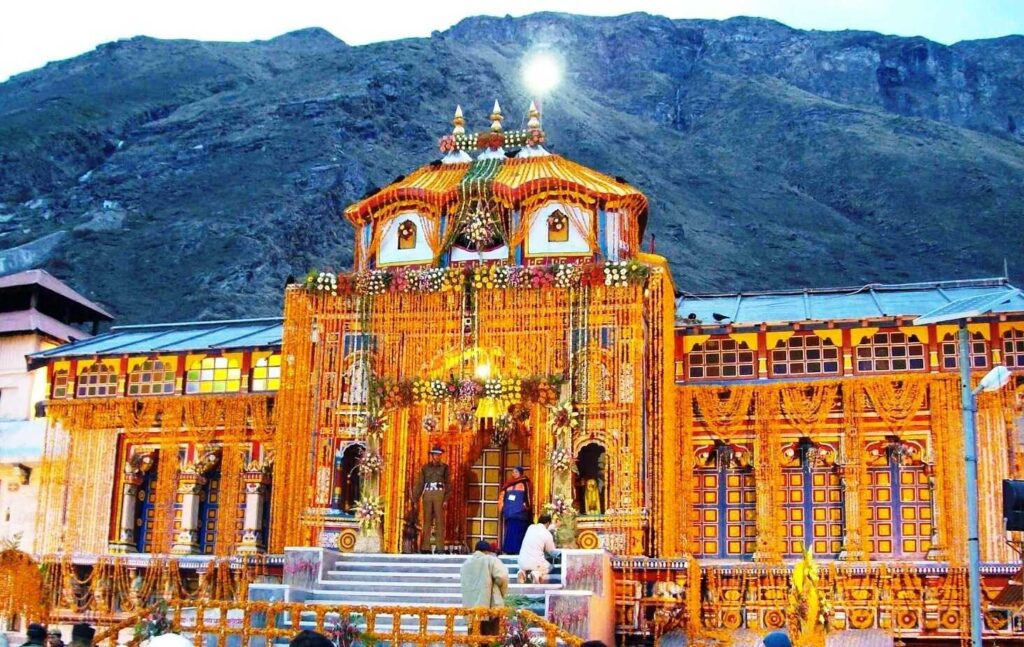
The Aarti (ritual of prayer with lighted lamps) at Badrinath is an important part of the temple’s daily worship and has a deep spiritual significance. The Badrinath Aarti is performed twice a day:
- Morning Aarti (Mangal Aarti)
Timing: This aarti is performed early in the morning, around 4:30 AM or just before sunrise. It is the first prayer of the day that marks the beginning of the temple’s rituals.
Significance: The Mangal Aarti is dedicated to Lord Vishnu (in his form as Badri Narayan), and it is believed to invoke the blessings of Lord Vishnu for the well-being of the devotees. The aarti is sung with great devotion, and pilgrims gather at the temple to participate in this sacred ritual.
The sound of the bell and the chant of mantras create an atmosphere of divine serenity, symbolizing the awakening of the deity. - Evening Aarti (Shayan Aarti)
Timing: The Shayan Aarti is performed in the evening, usually at 6:30 PM. It marks the closing of the temple’s daily rituals, and the idol of Lord Vishnu is put to rest for the night.
Significance: During the Shayan Aarti, the temple lamps are lit, and the chanting of sacred mantras fills the air. The aarti is performed with utmost devotion, thanking Lord Vishnu for his protection and blessings throughout the day.
It is a way of bidding farewell to the deity for the night, asking for his blessings, and seeking peace and protection until the morning.
Aarti’s Rituals:
Ghee Lamps: During both the morning and evening aartis, ghee lamps are lit and waved in front of the idol of Lord Vishnu.
Chanting of Mantras: Devotees and priests chant Vedic mantras, especially “Om Namo Bhagavate Vasudevaya”, and hymns in praise of Lord Vishnu.
Sacred Sound of Bells: The sound of temple bells is an essential part of the aarti. It creates a divine atmosphere and is believed to awaken divine energies.
Special Aartis:
Badrinath Temple’s Special Aarti (Brahma Muhurta Aarti) is another important occasion performed on special days like Akshaya Tritiya, Deepawali, and other festival days, when the rituals are more elaborate, and the devotees gather in large numbers for the divine experience.
The Aarti at Badrinath is not just a form of worship but an experience that connects devotees with the divine. The rhythmic chanting and the glowing lamps in the temple create an atmosphere of peace and spirituality, making it one of the most cherished rituals in the pilgrimage.